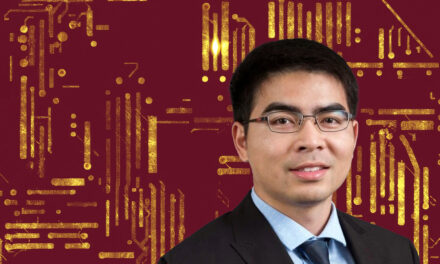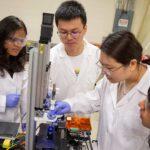
ASU robotics team makes a splash

Team picture with the Koi robot and MATE officials
The NASA Space Grant Robotics team at Arizona State University sent 10 team members to Orlando, Fla. in June to compete in the Marine Advanced Technology Education (MATE) international robotics competition.
Armed with Koi, a robot capable of functioning 30 feet underwater, the ASU team challenged 22 teams from across the country and across the globe, ranking 11th overall.
Matthew Plank, a computer systems engineering junior and NASA Space Grant intern, is the team’s president and has been competing in robotics competitions since high school.
“Robots allow you to go places humans typically can’t,” explains Plank, who helped design Koi’s electronics. “They allow for exploration and study of deep sea and space.”
The MATE competition, which ASU has competed in since 2009, focuses on ocean-related occupations and real-world industry problems. Each team is judged on their ability to “sell” a design that could solve a real-world crisis or fill an exploratory need.
For past competitions, teams designed robots that could deal with issues surrounding the 2010 Gulf Oil Spill or could explore underwater volcanoes. This year’s mission revolved around a sunken World War II vessel and its potential impact on the environment. The robots removed fluid from the fuel tank and surveyed and mapped the surrounding area.
“Each team is treated like a pseudo company,” said Michael Przeslica, electrical team lead and material science and engineering junior. “We are judged and scored based on a professional engineering presentation, a twenty page technical report detailing every aspect of our robot, a poster presentation, and carrying out a physical mission with our robot.”
During the physical mission each team had 15 minutes to complete approximately 20 underwater tasks.
The six months of work that the team put in culminated in the Martin Klein MATE Mariner Award for the team’s practical application of their knowledge and skills and for the desire to improve. This award included a $1,000 grant to support next year’s team.
The team came home with a second award. Emily McBryan, a senior aerospace engineering major, received the Engineering Evaluation Most Valuable Player individual award.
“I have been a member of this robotics team for four years now and this year the greatest lesson I have learned is how a team can come together and combine its talents in order to fulfill a mission. Koi is a great representation of not just our engineering skills but our teamwork skills and leadership ability,” says McBryan, who served as the robotics’ team president for the past two years.
The ASU/NASA Space Grant Robotics team does more than build award-winning robots, however.
“This is an opportunity to learn hands-on skills and to demonstrate leadership in the field,” and anyone who is willing to learn can join, Plank said.
About 20 active members with majors ranging from materials engineering and Earth and space exploration to computer science participate on the team. The team meets officially two days a week for two hours each, but Plank said that members are welcome to work as long as they are willing.
“We’re big on getting our hands dirty,” Przeslica said.
Phil Christensen, Regents’ Professor of Geological Sciences in ASU’s School of Earth and Space Exploration, provides lab space for the team in the Mars Space Flight Facility in the Moeur building.
“We like to surround ourselves with the spirit of exploration,” Przeslica said, adding that the research that is conducted around them is an inspiration for the team.
The team also competes in the National Underwater Robotics Challenge competition and will be adding the Association for Unmanned Vehicle Systems International competition, which focuses on fully autonomous robots, to its schedule this year.
In addition to learning real-world skills, Anthony Hallas, a computational mathematical sciences senior, said that his experience on the robotics team has had a practical application to his classwork.
The group is mentored by Shea Ferring, propulsion engineering manager for Orbital Sciences Corporation and Space Grant alumnus, and ASU graduate student Robert Wagner.
Although the group has mentors, Plank said that the team is student-run and members learn from each other more than anything else.
He added that the “hands-off” dynamic has encouraged members to learn to work with other engineers and learn something completely different from their respective majors.
“You can never downplay how important actually doing engineering and learning from other members is,” Plank said.
The team relies on NASA Space Grant support, donations and awards for material costs and travel to competitions. Unfunded travel costs are paid by students determined to see their project from beginning to end. Their current robot, Koi, is valued at approximately $6,900. For this year’s competition, they plan to design and build new systems with upgraded capabilities.
Written by Kristen Hwang
Media contact:
Nikki Cassis, [email protected]
602-710-7169
School of Earth and Space Exploration



































